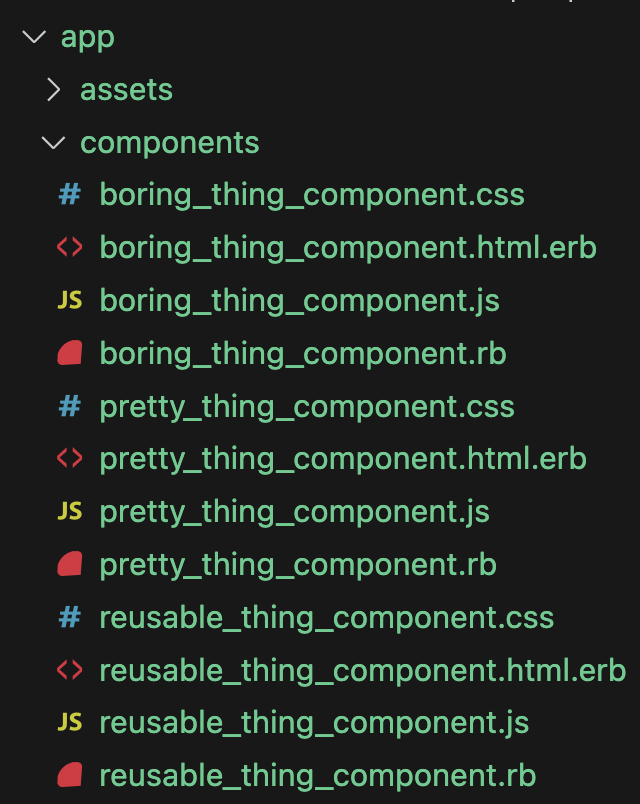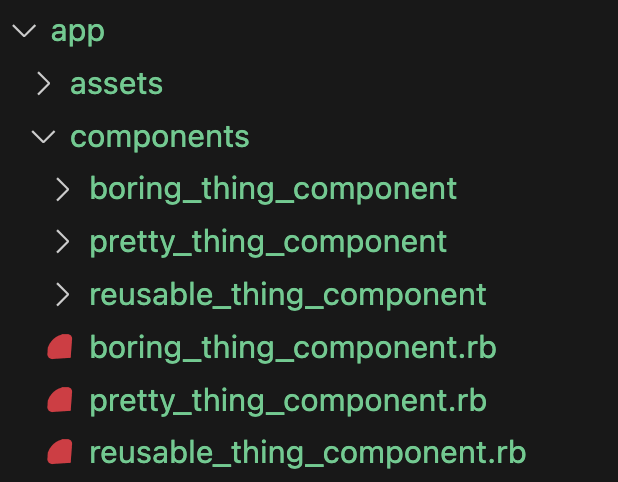Restructuring ViewComponents
I really like working with ViewComponents in Rails. There are so many positives compared to Action View, including:
- a separation of concerns by allowing views to remain presentational, and keeping logic in a view model;
- fast and comprehensive testing;
- a strict interface that requires all parameters to be predefined; and
- 10x better performance than Action View partials.
One thing that has always annoyed me, however, is the file structure. By default, all files are scattered in the same directory, which can be hard to navigate, particularly if you have CSS and JS bundled with your component.

ViewComponent does offer the ability to sidecar your assets, but you still need to keep the Ruby file outside of the sidecar directory. While this can substantially reduce the clutter, the default ordering in the VS Code Explorer creates a separation between the Ruby file and the sidecar directory.

My first attempt at making the file structure of ViewComponent feel nicer was to simply change the ordering of the VS Code Explorer, but I soon realised that I consider the default ordering to be far better in most cases; it was only ViewComponent that was causing me problems.
This week I was introduced to the view_component-contrib gem. One of their features is restructuring ViewComponents so that all related files are in the same directory, and you can drop the term “component” from your components. Instead of:
app/
components/
example_component/
example_component.css
example_component.html.erb
example_component.js
example_component.rb
You can have:
app/
components/
example/
component.html.erb
component.rb
index.css
index.js
While I appreciate the out-of-the-box thinking, I don’t like this either. I’ve encountered issues in the past when lots of files are called the same thing. When searching for a component, even if you include the directory in your search, you’ll often need to check the full path to be sure you are about the open the correct file:

Because Ruby is a dynamically typed language, it is also harder to click a reference to go to the class definition. The modern tooling is getting very good at defaulting the selection to the correct class, but you still need to stop and check the results:

Instead, I’ve been experimenting with changing the Rails default, using Components as a namespace, placing all component files in the same directory, but not including that presentational directory in the namespace.

Zeitwerk#
Thankfully, the autoloader used by Rails, Zeitwerk, is quite configurable. To get the outcome I was looking for, I created an initializer, config/initializers/autoloader.rb:
# frozen_string_literal: true
# The default configuration of View Components can be frustrating. Either you have lots of files
# littered around the app/components directory, or you sidecar your assets but have your Ruby file
# outside of the sidecar.
# In the latter case, the VS Code default is to organise the explorer so that directories are all
# first, followed by files. While this can be changed, the default sort is generally better, but it
# separates the Ruby and asset files.
#
# The following configuration makes it possible for:
# - the components directory to become a namespace;
# - all files related to a component to be grouped in a single directory; and
# - the presentational/grouping directory to be ignored in namespacing.
#
# For example, a component called `ReusableThing` would be defined in:
# `app/components/reusable_thing/reusable_thing.rb`
# resulting in the class:
# `Components::ReusableThing`
#
# Alternatively, you might like to nest/group your components. For example, if you wanted to group
# all components related to forms, you could have:
# `app/components/forms/text_input/text_input.rb`
# resulting in the class:
# `Components::Forms::TextInput`
#
# N.B. this configuration assumes that, if a directory has sub-directories, it should be ignored.
# This means you couldn't do something like:
# - `app/components/forms/text_input/text_input.rb`
# - `app/components/forms/text_input/variation/variation.rb`
# In this case, TextInput would not be collapsed, and so it would be expected that text_input.rb
# defines `Components::Forms::TextInput::TextInput`
# See https://edgeguides.rubyonrails.org/autoloading_and_reloading_constants.html#custom-namespaces
module Components; end
components_dir = Rails.root.join("app/components").to_s.freeze
Rails.autoloaders.main.push_dir(components_dir, namespace: Components)
# Only required for Rails < 7.1
ActiveSupport::Dependencies.autoload_paths.delete(components_dir)
Rails.application.config.watchable_dirs[components_dir] = [:rb]
def collapse_presentational_directories(path)
children = Dir.children(path)
if children.any? { File.directory?("#{path}/#{_1}") }
collapse_children(path, children)
else
Rails.autoloaders.main.collapse(path)
end
end
def collapse_children(path, children)
children.each do |child|
child_path = "#{path}/#{child}"
next unless File.directory?(child_path)
collapse_presentational_directories(child_path)
end
end
Dir.children(components_dir).
find_all { File.directory?("#{components_dir}/#{_1}") }.
each { collapse_presentational_directories("#{components_dir}/#{_1}") }
Generators#
The last piece of the puzzle is to reconfigure the generators to know about the structure, otherwise calling rails g component ReusableThing will put the files in the default locations with the default naming structure.
To minimise duplication of effort, I decided to extend upon ViewComponent’s AbstractGenerator:
# lib/rails/generators/hash_not_adam/abstract_generator.rb
# frozen_string_literal: true
require "rails/generators/abstract_generator"
module HashNotAdam
module AbstractGenerator
include ViewComponent::AbstractGenerator
private
def destination_directory
File.join(component_path, class_path, destination_file_name)
end
def destination_file_name
file_name
end
end
end
Then I created custom generators for the features I use (Ruby/ERB/RSpec).
# lib/rails/generators/component/component_generator.rb
# frozen_string_literal: true
require "rails/generators/hash_not_adam/abstract_generator"
module Rails
module Generators
class ComponentGenerator < Rails::Generators::NamedBase
include HashNotAdam::AbstractGenerator
source_root File.expand_path("templates", __dir__)
argument :attributes, type: :array, default: [], banner: "attribute"
check_class_collision
class_option :inline, type: :boolean, default: false
class_option :locale, type: :boolean, default: ViewComponent::Base.config.generate.locale
class_option :parent, type: :string, desc: "The parent class for the generated component"
class_option :preview, type: :boolean, default: ViewComponent::Base.config.generate.preview
class_option :stimulus, type: :boolean,
default: ViewComponent::Base.config.generate.stimulus_controller
def create_component_file
template "component.rb", File.join(destination_directory, "#{file_name}.rb")
end
hook_for :test_framework
hook_for :preview, type: :boolean
hook_for :stimulus, type: :boolean
hook_for :locale, type: :boolean
hook_for :template_engine do |instance, template_engine|
instance.invoke template_engine, [instance.name]
end
private
def parent_class
return options[:parent] if options[:parent]
ViewComponent::Base.config.component_parent_class || default_parent_class
end
def initialize_signature
return if attributes.blank?
attributes.map { |attr| "#{attr.name}:" }.join(", ")
end
def initialize_body
attributes.map { |attr| "@#{attr.name} = #{attr.name}" }.join("\n ")
end
def initialize_call_method_for_inline?
options["inline"]
end
def default_parent_class
defined?(ApplicationComponent) ? ApplicationComponent : ViewComponent::Base
end
end
end
end
# lib/rails/generators/component/templates/component.rb.tt
# frozen_string_literal: true
<% namespaces = class_name.split("::"); last_namespace_index = namespaces.count - 1 %>
module Components
<% namespaces.each_with_index { |namespace, index| %><%=
" " * ((index + 1) * 2)
%><%=
if index == last_namespace_index
"class #{namespace} < #{parent_class}\n"
else
"module #{namespace}\n"
end
%><% } %>
<%- if initialize_signature -%>
def initialize(<%= initialize_signature %>)
<%= initialize_body %>
end
<%- end -%>
<%- if initialize_call_method_for_inline? -%>
def call
content_tag :h1, "Hello world!"<%= ", data: { controller: \"#{stimulus_controller}\" }" if options["stimulus"] %>
end
<%- end -%>
<% last_namespace_index.downto(0) { |index| %><%=
" " * ((index + 1) * 2)
%><%=
"end#{"\n" if index.positive?}"
%><% } %>
end
# lib/rails/generators/erb/component_generator.rb
# frozen_string_literal: true
require "rails/generators/erb"
require "rails/generators/hash_not_adam/abstract_generator"
module Erb
module Generators
class ComponentGenerator < Base
include HashNotAdam::AbstractGenerator
source_root File.expand_path("templates", __dir__)
class_option :inline, type: :boolean, default: false
class_option :stimulus, type: :boolean, default: false
def engine_name
"erb"
end
def copy_view_file
super
end
private
def data_attributes
if options["stimulus"]
" data-controller=\"#{stimulus_controller}\""
end
end
end
end
end
# lib/rails/generators/erb/templates/component.html.erb.tt
<div<%= data_attributes %>>Add <%= class_name %> template here</div>
# lib/rails/generators/rspec/component_generator.rb
# frozen_string_literal: true
module Rspec
module Generators
class ComponentGenerator < ::Rails::Generators::NamedBase
source_root File.expand_path("templates", __dir__)
def create_test_file
template "component_spec.rb", File.join("spec/components", class_path, "#{file_name}_spec.rb")
end
end
end
end
# lib/rails/generators/erb/templates/component_spec.rb.tt
# frozen_string_literal: true
require "rails_helper"
RSpec.describe Components::<%= class_name %> do
pending "add some examples to (or delete) #{__FILE__}"
# it "renders something useful" do
# expect(
# render_inline(described_class.new(attr: "value")) { "Hello, components!" }.css("p").to_html
# ).to include(
# "Hello, components!"
# )
# end
end
Conclusion#
This is very much a proof-of-concept that I’ve only tested at small scale, and I’d love to hear what other people think (especially if you have concerns).
Until I’ve seen this running for longer, and with many more components, I’m going to be concerned that:
- there could be edge cases I’ve not considered;
- iterating over the file system to collapse directories might not be efficient at scale; and
- it won’t be obvious to anyone new to the project that Zeitwerk has been modified.
I also haven’t yet looked at Previews, but I would like to move those into the same directory. This is something that view_component-contrib is already doing. While I would want to use a different naming convention, it should be easy enough to reverse-engineer.